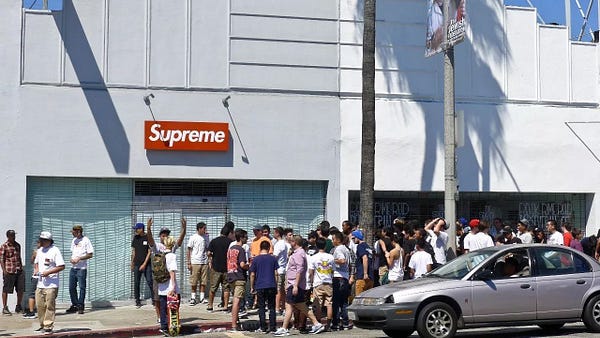The Hype Phenom: Supreme

Materialism is common in our society. From the time when the Soviet Union collapsed in 1991, capitalism has, arguably, ruled our world and has been deep-rooted into both millennial and young minds like ours today. The human population yearns to consume and the scarcity of our resources only give them more value: the materialistic value of exclusivity and scarcity. “Hype brands” exploit and profit from this very tendency to consume. Their manipulation of markets and consumer’s tastes and preferences is a feat of economics, and of unparalleled growth. Supreme is one such brand as it has successfully become a master of twisting the perceived value of its items and become one of the top street wear brands. Recently valued at $1 billion, Supreme has earned a name for itself in the street-wear-fashion industry and as a must-have brand hype-beasts want in their collections. However, the brand did have humble origins, and we can only understand their success by looking at their roots.

Supreme started out as a skateboarding shop in the 1980s with their now iconic box logo and aimed to sell their products to the members of the New York skate community aged 18–24. Three decades later, we see the same road DNA, but now, worldwide, selling to both millennials and the Gen Z. Brands such as Supreme thrive on their image. Seen as being for the elite and those with deep pockets, the firm pulled off a strategy that several other popular companies such as Super-dry have been unable to. Supreme has indeed outdone itself.
Founder James Jebbia once said in an interview with Complex, “It’s not like when we’re making something, we make only six of them. But if we can sell 600, I make 400.” In a nutshell, this strategy is at the heart of how Supreme operates. Basic instinct and economics say that the scarcer the good is, the more the demand, the higher the price. The presence of scarcity is quite evident. This very nature is what drives the market to jump at every opportunity to consume Supreme products every time it releases a drop of a new collection. However, there is still a key element missing: desire. Without the paranoia that queuers exhibit, Supreme would have been bankrupt long before we heard of its name outside of America. Marketing is essential to any brand’s continuous success. That is why Supreme has succeeded. Anyone can reduce production, but can everyone get celebrities such as Justin Bieber and Drake to wear their products? Can everyone have collaborations with well-established luxury brands such as Louis Vuitton? Perfectly placed to sell to their target market, eminent personalities influence the Generation Z beyond what I believe is good for us. As malleable teenage personalities yearning to achieve a good social standing, we are turning into, what some of us already are, social animals. At least in the minds of the desperadoes waiting for hours on end hours before ‘drop day’ the exclusivity of the clothing translates into eliteness or what some may call ‘coolness’ when it is worn, or even collected and displayed. Simply, this turns desire into a need which has compelled so many bank accounts to be emptied.

The overwhelming appetite to consume such products also creates a secondary market, one of the re-sellers and legal fakes for those who are not as liquid. If I want something you have bad enough, it gives said possession, which may have had no value to you at all, a perceived value for which it can be sold. Much to the pain of the company, secondary re-sellers often sell Supreme merchandise at prices much higher than retail, earning a mean profit and decreasing the scarcity of the product. Nonetheless, as James Clifton of VICE aptly puts it, “the buzz around the brand is what sustains that same buzz.” This statement clarifies the use of collaborations and limited availability.
In my opinion, Supreme is no less than art. Art may or may not be aesthetically pleasing, yet it is the story behind the piece and the auctioneer’s ability to sell which ultimately lands staggering dollar bids in seven-figure numbers at auctions. Art can be a silent albeit powerful statement; the message. Supreme is that auctioneer and the box logo on everything it sells is that story and message, a status symbol in red and white.


Leave a Reply
Authentication required
You must log in to post a comment.
Log in